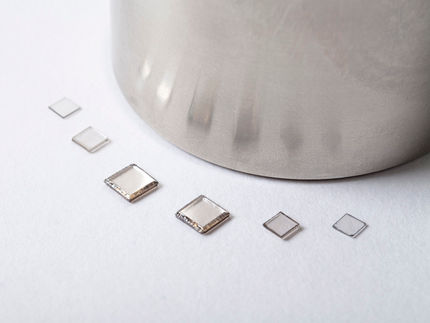The quantum avalanche
At the Vienna University of Technology, it was possible to keep a system that is actually very unstable, consisting of many quantum particles, stable and then release its energy in a targeted manner all at once
These are very special diamonds that are being worked with at TU Wien: Their crystal lattice is not perfectly regular, it contains numerous defects. In places where there would be two neighboring carbon atoms in a perfect diamond, there is a nitrogen atom, leaving the second place empty. Microwaves can be used to switch these defects between two different states - a higher energy state and a lower energy state. This makes them an interesting tool for various quantum technologies, such as novel quantum sensors or components for quantum computers.
Now, the researchers have succeeded in controlling these defects so precisely that they can be used to trigger a spectacular effect: All defects are brought into the high-energy state, in which they remain for some time, until one then releases all the energy with a tiny microwave pulse and all defects simultaneously change to the low-energy state - similar to a snowfield on which a tiny snowball triggers an avalanche and the entire mass of snow thunders down into the valley at the same time.

Computer visualization of the microwave resonator with superconducting chips and diamond (black). The silver wave represents the quantum avalanche - the sudden emission of an electromagnetic pulse.
Atomic spins and microwaves
"The defects in the diamond have a spin - an angular momentum that points either up or down. These are the two possible states they can be in," says Wenzel Kersten, first author of the current publication, who is currently working on his dissertation in the research group of Prof. Jörg Schmiedmayer (Atomic Institute, Vienna University of Technology).
With the help of a magnetic field, one can achieve that, for example, the "spin up" state corresponds to a higher energy than "spin down." In this case, most atoms will be in the "spin down" state - they normally gravitate to the lower energy state, like a ball in a bowl that normally rolls downward.
But with some clever engineering tricks, it's possible to create what's called an "inversion" - you get the defects to all settle into the higher energy state. "You use microwave radiation for this, by which you first bring the spins into the desired state, then you change the external magnetic field so that the spins are frozen in this state, so to speak," explains Prof. Stefan Rotter (Institute for Theoretical Physics, Vienna University of Technology), who led the theoretical part of the research.
Such an "inversion" is unstable. In principle, the atoms could spontaneously change their state - similar to balancing a broomstick, which in principle can spontaneously tip over in any direction. But the research team was able to show: Extremely precise control, made possible by chip technology developed at TU Wien, can keep the spins of the atoms stable for about 20 milliseconds. "By quantum physics standards, that's a huge amount of time. That's about a hundred thousand times as long as it takes to create this high-energy state or to discharge it again. That's like having a cell phone battery that is charged in an hour and then holds its energy completely for ten years," says Jörg Schmiedmayer.
Tiny cause - big effect
During this time, however, it is possible to bring about the change of state in a targeted manner - and to do so by means of a very small, weak cause, such as a microwave pulse of minimal intensity. "It causes an atom to change its spin, whereupon neighboring atoms also change their spin - thus creating an avalanche effect. All the energy is released, in the form of a microwave pulse that is about a hundred billion times stronger than the one used to trigger the effect originally," explains Stefan Rotter. "That is proportionally as if a single snowflake were to trigger a snow slab weighing several hundred tons."
This offers many interesting possibilities: For example, one can amplify weak electromagnetic pulses in this way, one could use this for special sensors, one can use it to create a kind of "quantum battery" with which a certain amount of energy can be stored and released in a targeted manner at the quantum level.
Note: This article has been translated using a computer system without human intervention. LUMITOS offers these automatic translations to present a wider range of current news. Since this article has been translated with automatic translation, it is possible that it contains errors in vocabulary, syntax or grammar. The original article in German can be found here.

























































